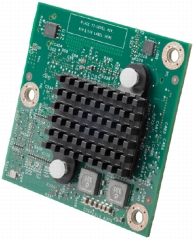|
|
Product Overview
The Cisco® Fourth-Generation Packet Voice Digital Signal Processor Module (PVDM4) enables Cisco 4451-X Integrated Services Routers (ISRs) to provide rich-media capabilities such as high-density voice connectivity, conferencing, transcoding, media optimization, transrating, and secure voice in Cisco Unified Communications Solutions.
The fourth-generation packet voice digital-signal-processor (DSP) modules are available in four densities: PVDM4-32, PVDM4-64, PVDM4-128, and PVDM4-256, with 32, 64, 128, and 256 channels, respectively (Figure 1). Tables 1 and 2 show the number of voice channels and codecs that each PVDM4 module supports.
Figure 1. PVDM4 Top View

Features and Benefits
The PVDM4 modules are supported on the Cisco 4451-X platform. You can plug them directly into the single slot on the router motherboard or onto the network interface module (NIM) that supports T1/E1 ports. Enhanced DSP architecture accommodates a new packet-processing engine optimized for rich-media voice applications, while concurrently supporting the time-division multiplexing IP (TDM-IP) voice framework.
A PVDM4 module plugged onto the motherboard delivers IP-based voice services such as conferencing, media optimization, and transcoding. A PVDM4 module plugged onto the NIM daughter card would be used for voice T1/E1 connectivity.
All the PVDM4 modules have the same form factor and are field-upgradable to allow you to easily scale your voice deployments.
Codec Support and Capacity
The PVDM4 modules support a wide range of codecs of different complexities. They support all codecs that are supported by the PVDM3 modules. Table 1 lists the codecs supported on the PVDM4 modules, and Table 2 gives the channel densities of the PVDM4 modules. Table 3 lists the media-enhancement features.
Table 1. Voice, Fax, and Modem Codec Support on PVDM4 Modules
Table 2. Channel Densities of PVDM4 Modules
Table 3. Media Enhancement Features
Conferencing, Transcoding, and Transrating Services
The PVDM4 modules support digital voice connections, conferencing, and universal transcoding services. The PVDM4-256 can support up to 8conferences with 64 participants in each conference and up to 88 conferences with 8 participants in each conference. Please refer to the PVDM4 Q&A for more information about the number of supported sessions.
In conjunction with Cisco IOS® Software, the PVDM4 modules support universal transcoding and the same codec repacketization as the PVDM3 modules. Universal transcoding allows transcoding from any supported codec to any other supported codec. Refer to the PVDM4 Q&A for more details about the number of supported sessions for each codec.
The PVDM4 modules support transrating, where repacketization of the same codec is used to connect dissimilar networks that have different codec packetization periods.
Voice-Quality Management
The PVDM4 modules perform compression, voice-activity-detection, jitter-management, and echo-cancellation functions. The echo cancellation offered in the PVDM4 modules has a tail length of 128 milliseconds (ms) and complies with ITU-T G.168.
Energy-Saving Feature
The PVDM4 DSPs offer multiple power-saving modes, including a power-saver mode when the module is not in use. In power-saver mode each PVDM4 can save up to 5 watts of power.
Cisco Platform Availability
The PVDM4 modules are supported on Cisco 4451-X platforms. The platform has one slot for the PVDM4 module. You can plug any additional PVDM4 modules onto the T1/E1 NIMs.
Note that PVDM3 modules are not supported on the Cisco 4451-X, and PVDM4 modules are not supported on the Cisco 2900 and 3900 Series platforms.
Product Specifications
Table 4 gives module specifications.
Table 4. Module Specifications
Ordering Information
Table 5 gives ordering information for the modules.
Table 5. Ordering Information
To place an order, visit the Cisco Ordering Home Page and refer to Table 5. To download software, visit the Cisco Software Center.
Cisco and Partner Services for the Branch Office
Services from Cisco and our certified partners can help you transform the branch-office experience and accelerate business innovation and growth in Borderless Networks. We have the depth and breadth of expertise to create a clear, replicable, optimized branch-office footprint across technologies. Planning and design services align technology with business goals and can increase the accuracy, speed, and efficiency of deployment. Technical services help improve operational efficiency, save money, and mitigate risk. Optimization services are designed to continuously improve performance and help your team succeed with new technologies.